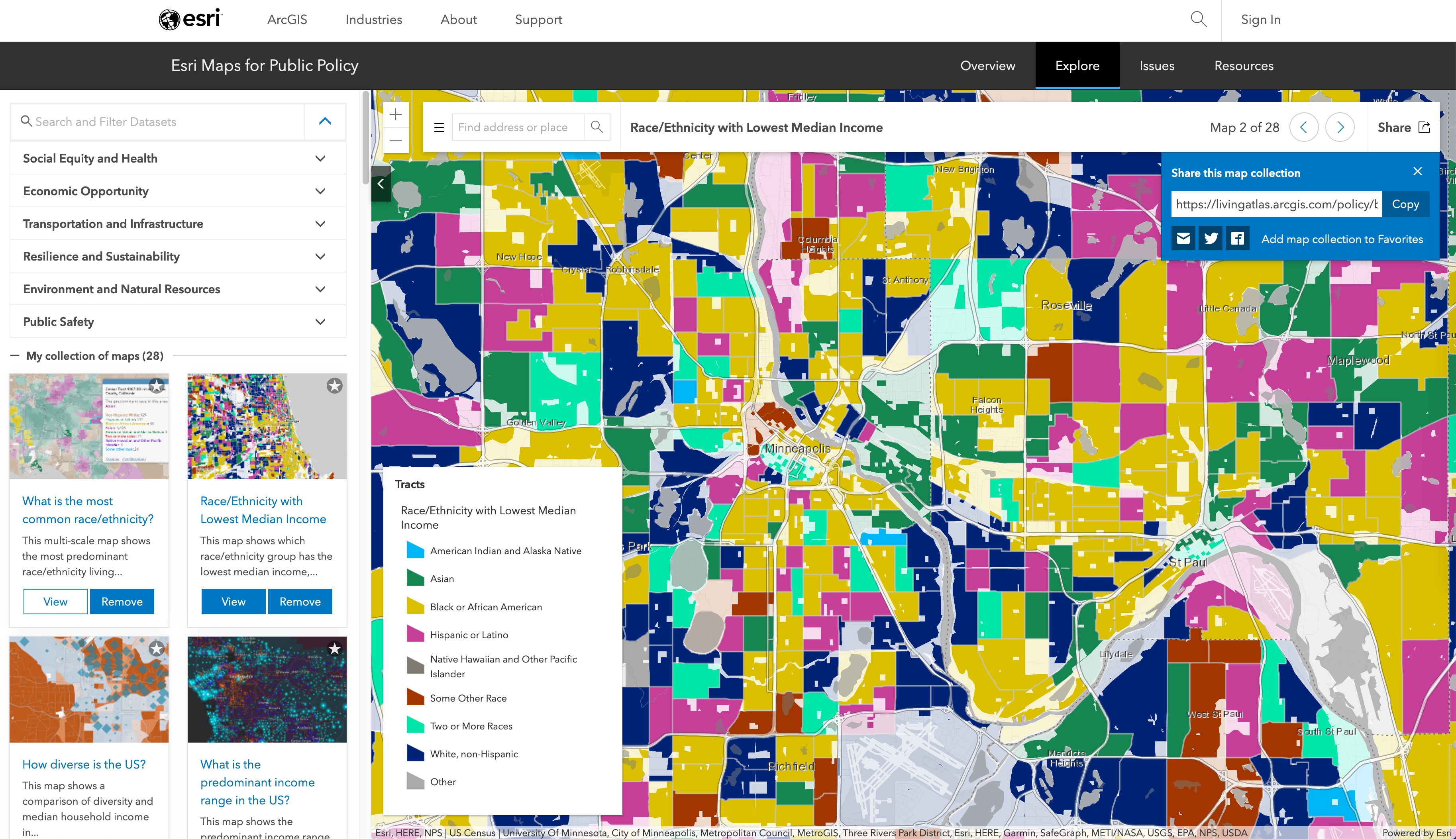- Home
- :
- All Communities
- :
- Industries
- :
- Education
- :
- Education Blog
- :
- Fun with GIS 276: Policy Maps for All
Fun with GIS 276: Policy Maps for All
- Subscribe to RSS Feed
- Mark as New
- Mark as Read
- Bookmark
- Subscribe
- Printer Friendly Page
Of all the remarkable collections of maps and apps Esri offers for exploration, one of my faves for a teacher is the Policy Maps collection. (See Fun with GIS 259 for background.) Not just a grab bag of maps, it is an environment in which users can study deeply, discover quickly, and share widely, exploring key patterns in their community, and do it all without login. Most maps have scale-dependent data and rich info waiting to be exposed by clicking on an area.
Wanting to create a resource for teachers in various conditions to use, I assembled a set of 28 from the hundreds available. Educators can explore, re-center to their region, subset, and distribute to their students via shortURL or email, all in under 10 minutes, giving students hours of investigation and discovery.
In a single click, you have those 28 maps at your fingertips, without login (navigate using the panel at left or "<" and ">" arrows at top right). In seconds, you can recenter the map to your location in the 50 states, then export a different shortURL (for Twitter) or full email with contents and link.
My set centered on Minneapolis and St.Paul. Go to https://arcg.is/1KSPjH for this pre-built sequence:
- What is the most common race/ethnicity?
- Race/Ethnicity with Lowest Median Income
- How diverse is the US?
- What is the predominant income range in the US?
- How expensive are living costs in your area?
- Households who spend more than 30 percent of income on housing
- Emergency Expense Risk Index
- Ratio of People Living Above vs. Below the Poverty Line
- Children in Poverty
- Where are disconnected youth?
- Are Youth Learning, Earning, Both, or Neither?
- Where are young adults living with their parents?
- Where are the people who started college but did not finish?
- Population 25+ with Bachelor's Degree or Higher Education Level (ACS)
- People in Households with No Internet Access
- Where are households using a Smartphone as their only computing device?
- Where are the most socially vulnerable populations in the U.S.?
- Where are those aged 65 and older?
- Where are adults with limited English ability?
- Unemployment in the United States in 2018
- Where do People Have Medicaid/Means-Tested Healthcare?
- Where are the Uninsured?
- Females with Disabled Status
- Males with Disabled Status
- Supermarket Access Map
- Job Accessibility by Walking and Transit (selected cities)
- Where are the Households with No Vehicle Available?
- Where didn't people self-respond to the 2020 Census?
How could you teach with your version of this? Here are some ideas:
- Pick any 4 maps. Summarize some key patterns noticed. What highs and lows are visible? Are there factors which seem to vary directly or inversely?
- Challenge students to create their own subset (e.g. 5, which could include maps I did not choose) that highlight salient features of your region relating to a current issue.
- Ask students to explore a distant target community of note (regionally or nationally) and highlight differences between your home and the target.
- Explore local discussions about equity and how the data does or doesn't match what is being described publicly.
- Have students take on the roles of residents, mayor, or community planner, and identify some targets to explore more deeply, and even some strategies for building solutions.
If a picture paints a thousand words, a single map tells volumes of stories, and the combinations of content have limitless potential, for uncovering the impact of yesterday's events and policies, or discovering ways to build a better world today. Where will you explore?
You must be a registered user to add a comment. If you've already registered, sign in. Otherwise, register and sign in.
-
Administration
78 -
Announcements
80 -
Career & Tech Ed
1 -
Curriculum-Learning Resources
257 -
Education Facilities
24 -
Events
72 -
GeoInquiries
1 -
Higher Education
595 -
Informal Education
281 -
Licensing Best Practices
91 -
National Geographic MapMaker
33 -
Pedagogy and Education Theory
224 -
Schools (K - 12)
282 -
Schools (K-12)
272 -
Spatial data
35 -
STEM
3 -
Students - Higher Education
245 -
Students - K-12 Schools
128 -
Success Stories
36 -
TeacherDesk
1 -
Tech Tips
117
- « Previous
- Next »
